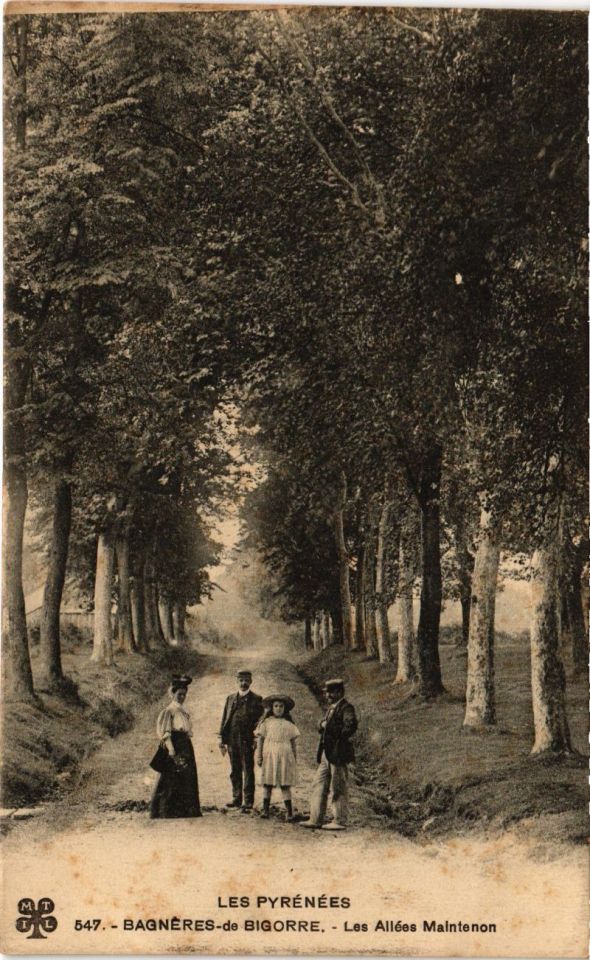#Bagnères de Bigorre
Explore tagged Tumblr posts
Text

Saint-Lary-Soulan, Hautes-Pyrénées, Occitania.
#Saint-Lary-Soulan#Canton of Neste#Arrondissement of Bagnères-de-Bigorre#Hautes-Pyrénées#Occitania#France
150 notes
·
View notes
Text

Greetings from Bagnères-de-Bigorre, Bigorre region of France
French vintage postcard
#postcard#ansichtskarte#briefkaart#france#photography#carte postale#vintage#postkarte#photo#historic#postkaart#bagnères-de-bigorre#ephemera#bigorre#sepia#bagnres#region#french#greetings#tarjeta#postal
6 notes
·
View notes
Text

Bagnères-de-Bigorre, le centre médical.
32 notes
·
View notes
Text

Bouquet d'oeillets Blanche Odin (French, 1865–1957)
Blanche studied with watercolorist Madeleine Jeanne Lemaire in Paris, because art schools were closed to women. In 1902 she opened her own workshop. Blanche's works, especially still lifes, were a great success and were favorably assessed by critics and were exhibited in Parisian galleries. She has produced a body of work that is a reflection of France’s tradition in impressionism, and serves as an example of painting during the years between Post-Impressionism and Cubism. Her works are in the collection of the Musée Salies in Bagnères-de-Bigorre.
Other painter's works: https://www.artnet.com/artists/blanche-odin/
#dianthus#carnation#painting#still life#flowers#flower vase#20th century painting#19th century painting#french art#women in art#woman painter#woman artist#Blanche Odin#ceramic vase#woman artwork#fine art
6 notes
·
View notes
Text

Bagnères-de-Bigorre. Intérieur paysan en 1930.
45 notes
·
View notes
Text

Streetart by Rémi Tournier @ Bagneres de Bigorre, France, for Ville de Bagnères-de-Bigorre
More pics at: https://barbarapicci.com/2023/12/06/streetart-remi-tournier-bagneres-de-bigorre-france/
8 notes
·
View notes
Text

Dome of the observatory of the Pic du Midi de Bigorre under a starry sky, Bagnères-de-Bigorre, La Mongie, Hautes-Pyrénées, France
7 notes
·
View notes
Text
Crac ! Boum ! Hue ! (etc...)
Surtout, ne me faites pas dire ce que je ne pense pas : ce titre n'est en rien une revendication de ma part. Non, je n'ai pas, comme Jacques Dutron avait la chance d'en avoir un dans sa jeunesse, ''un piège à filles, un truc tabou, Un joujou extra qui fait crac boum hue''... Et, hélas, ''Les filles ne tombent pas à mes genoux''. En revanche, dans mon immeuble parisien, un voisin a profité de ses vacances pour se lancer dans des travaux iso-hidalguesques. Je ne sais pas à quelles destructions sont destinés les bruits incroyables qui provoquent mon réveil depuis quelques matins, mais ses corps de métiers doivent se prendre pour des décathloniens... ou pour le ''truc'' de Dutron !
Si je vous raconte ça, c'est parce que grâce à une ''pub'' parue dans le quotidien gratuit ''20 minutes'' et transmise par Alain Rémond, de ''La Croix'', je suis tombé sur une proposition d'expérimenter une toute nouvelle technique dite ''de relaxation sonore'' : si je veux vraiment être enfin bien dans ma tête, dans mon corps, et partout ailleurs, il me faut absolument ''des vibrations sonores''. Question à 100 $ (US) : ''C'est grave, docteur ?''. La réponse est : on verra plus tard... car pour le moment, il semblerait que je manque dramatiquement de cette invention ''ultra-quelque chose '' et ''extra-pleine de trucs'', dont une sophrologue-spécialisée-en-relaxation-sonore vante les mérites indubitables (?) dans la dite pub. ''Ces massages sonores, affirme-t-elle sans faiblir, sont la base d'une science nouvelle, la (je cite) sonopuncture'' qui, si j'ai tout compris, serait exactement la même chose qu'une acupuncture dont l'aiguille serait remplacée par des sons (c'est un peu comme un coq au vin, qui serait fait avec des andouilles de vire et des tripes à la mode de Caen !).
''Les vibrations sonores –explique-t-elle-- se propagent à travers les os, et le cerveau est (donc ?) directement atteint sans effort'' (Questions : atteint où, par quoi, venant de qui ?). Le résultat est sans appel : c'est épatant ! On est relaxé dans tous les sens, comme jamais. Et c'est pour qui, toutes ces merveilles ? Mais pour tout le monde, voyons ! Pour vous et pour votre belle-mère... ce qui m'a remis en mémoire une émission récente de FR3, sur le thermalisme : devant l'effondrement du nombre de gens intéressés par ce sport, la station de Bagnères-de-Bigorre a remplacé la fréquentation de ses sources chantantes par... des siestes interminables sur un lit sous lequel des abeilles (par milliers, par trilliers, par ruches entières) font vibrer leurs ailes... ce qui vous guérit de toutes les mêmes choses que ''les eaux'' jusque là (ça me fait penser aux belles-mères à cause de la possibilité d'une erreur d'aiguillage qui donnerait à ces hyménoptères pleins de piquant(s) l'envie de se tromper d'étage... et là, ''Bonjour les dégâts'' !).
Vous allez me dire : quel lien avec ton voisin d'immeuble ? Mais voyons... dans le caractère relaxant et curatif du bruit ! Je veux parler du miracle de la ''sonothérapie'', dont je suis en mesure de mesurer à leur juste mesure les avantages (pour moi rigoureusement introuvables) et les inconvénients (dont je tiens la liste à votre disposition : elle n'entre pas dans les limites fixées par mon fournisseur d'espace !). Mais je peux vous dire que, depuis quelques jours, j'expérimente, à fond la caisse, les massages sonores, les voyages éponymes, la sono- et la -puncture et que, jusqu'à cet instant, cela ne marche pas avec ou sur moi. Mais alors... pas du tout !
En fait, si quelqu'un pouvait être intéressé par mon avis (ce qui est rarement le cas...), je dirais même que ça a un effet rigoureusement inverse : les perceuses et les marteaux-piqueurs semblent créer sur mon système nerveux des dégâts collatéraux qui me foutent un coup de vieux dont je n'avais absolument pas besoin. Je peux même vous dire que le seul fait d'entendre des murs d'habitude protecteurs se mettre à trembler comme un volcan en Islande, et menacer de s'écouler après s'être fissurés comme un hôpital à Gaza, m'angoisse et génère en moi des torrents de gros mots et d'insultes que je n'avais pas éructées depuis les années (à peu près trois, comme toute ma classe d'âge !) où je fréquentais assidûment l'institution militaire en tant que ''Maintenu''.
En fait, j'en ai même tiré une sorte de règle générale : ''Plus ça vibre, et plus je stresse !'', et plus je suis enveloppé, jeté, trimballé, secoué, violenté et j'en passe, dans une solitude généralement réservée aux coureurs de fond, pour paraphraser Alan Sillitoe (''The loneliness of the long distance runner'' –1959). Et, un peu comme les paysans français ou les habitants du Pas de Calais, j'ai une forte impression d'abandon, de ''trop, c'est trop'', et de ''personne ne m'aime''...
C'est d'ailleurs à cette impression d'abandon que vous devez cet édito encore plus ''déjanté'' que les autres : il fallait que je partage ma ''différence ressentie'' entre les textes qui circulent, en cette période où la folie sort de plus en plus souvent des asiles … et le ressenti, justement, d'un pauvre citoyen lambda confronté aux terribles réalités du siècle ! Pour un peu, je deviendrais sartrien (c'est vous dire combien je suis touché, en profondeur !), au point de penser que l'enfer, c'est le bruit des autres ! Bonne sieste et à demain, pour un sujet plus sérieux...
H-Cl.
3 notes
·
View notes
Text



[ENGLISH, french below] Meet me tomorrow in Bagnères-de-Bigorre to fill up on new drawings to color 🐰! ------------ [FRENCH] Retrouvez-moi demain à Bagnères-de-Bigorre pour faire le plein de nouveaux dessins à colorier 🐰!
6 notes
·
View notes
Text
Pyrénées : Un séisme enregistré au sud de Tarbes très fortement ressenti
Un séisme entre 4 et 4,7 s’est produit ce mardi à 11h23 à 9 km au sud de Tarbes et à l’est de Bagnères-de-Bigorre (Hautes-Pyrénées)
0 notes
Text

Maintenon alley in Bagnères-de-Bigorre, Gascony region of southern France
French vintage postcard
#historic#maintenon#photo#briefkaart#vintage#region#southern#sepia#photography#carte postale#alley#postcard#bigorre#postkarte#france#postal#tarjeta#ansichtskarte#french#old#ephemera#de#postkaart#bagnères-de-bigorre#bagnres#gascony
5 notes
·
View notes
Text
Streetart – Rémi Tournier @ Bagneres de Bigorre, France
Title: LES PIERRES PRÉCIEUSES Location: Bagneres de Bigorre, France Artist: Rémi Tournier For: Ville de Bagnères-de-Bigorre Size: 12x9m Year: 2023 …Streetart – Rémi Tournier @ Bagneres de Bigorre, France

View On WordPress
0 notes
Text

Tour des Jacobins, Bagnères-de-Bigorre, Hautes-Pyrénées.
1840
18 notes
·
View notes
Text

Vase œillets Blanche Odin (1865-1957, French)
Blanche studied with watercolorist Madeleine Jeanne Lemaire in Paris, because art schools were closed to women. In 1902 she opened her own workshop. Blanche's works, especially still lifes, were a great success and were favorably assessed by critics and were exhibited in Parisian galleries. She has produced a body of work that is a reflection of France’s tradition in impressionism, and serves as an example of painting during the years between Post-Impressionism and Cubism. Her works are in the collection of the Musée Salies in Bagnères-de-Bigorre.
Other painter's works: https://www.artnet.com/artists/blanche-odin/
#dianthus#carnation#painting#still life#flowers#flower vase#women in art#woman painter#french art#20th century painting#20th century art#Blanche Odin
1 note
·
View note
Text
La Mongie Ski Resort | Snowshoes hiking
Activity that combines fun, sport, and discovery. All winter, from the La Mongie Ski Resort, daily Snowshoes hiking to discover the treasures and dream landscapes.

The mountain in winter is not just skiing! The mountainside nature as soon as the snow is there… Fancy an activity that combines fun, sport and discovery? All winter, from the ski resort of La Mongie, daily snowshoe outings for half a day (morning and afternoon) or for the day, to discover the treasures and dream landscapes that the mountain conceals. With each walk you will discover an enchanting landscape! Places suitable for snowshoeing thanks to their gentle slopes and the treasures of the landscapes they conceal!
For children, the equipment is suitable and appropriate for a discovery of the activity from 5 years old. They will learn to play little trappers behind animal tracks … or even by venturing into igloo building! Before enjoying a good hot chocolate that I will be happy to offer you.
From 2 people, multiple possibilities in the country of your holidays. I offer you at your leisure, magnificent Nordic type hikes with easy snowshoeing, but also peaks with a little more sporty snowshoeing … With why not the waters of Aquensis, the balneo center of Bagnères de Bigorre to finish gently your day.
visit our site : https://www.lauthenticfrance.com/tour/snowshoes-hiking/
0 notes
